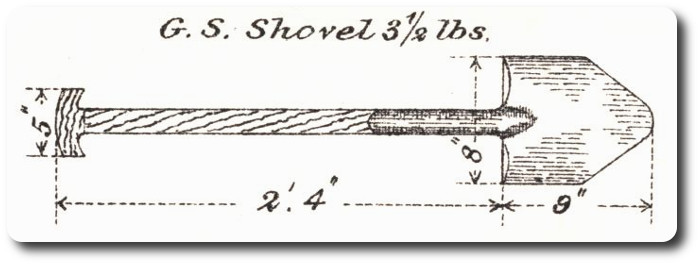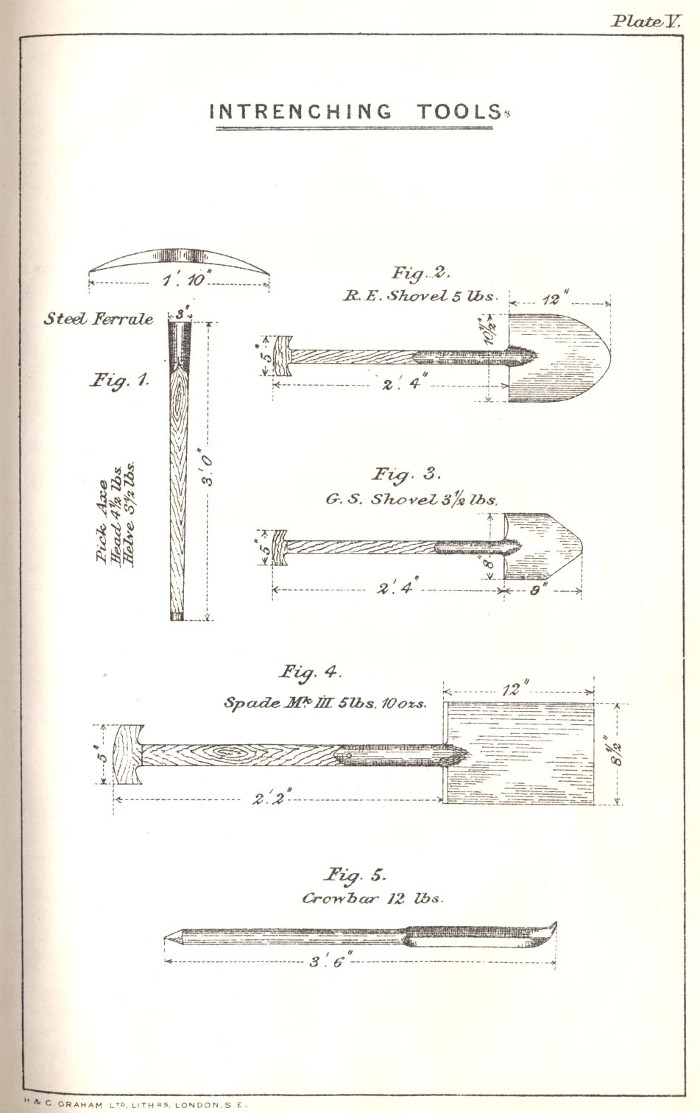Topic: Militaria

Intrenching Tools
Military Engineering (Part 1), Field Defences, 1908
Under the heading of intrenching tools are included pickaxes, shovels, spades and crowbars. The light intrenching tool will also be included as soon as it is issued to the army.
The latest pattern of pickaxe has a 4 ½ lb. Steel head, and a wooden helve with a steel ferrule to fit the head. The object of this ferrule is to strengthen the helve at the weakest point, and to make it easily detachable from the head.
A pickaxe with an 8 lb. Head can be obtained from Ordnance Stores if heavy work is expected.
The word "pickaxe" is usually abbreviated into "pick."
The R.E. shovel is a commercial pattern of shovel weighing about 5 lbs.
The G.S. shovel is a shovel similar to the above, but weighing only 3 ½ lbs., and having a much smaller blade.
Only a very small proportion of spades are carried, as they are of little use in the field. They are employed for cutting sods, for working in clay, and for digging generally when a pickaxe is not required.
Crowbars also are carried only in small numbers. They are of use for loosening rocks, making holes for pickets in hard ground, etc.

Use of Tools
Careful instruction and practice in the use of intrenching tools are essential to good and rapid work.
When using the full-sized tools, each digger is usually provided with a pick and a shovel. The shovel should be used only for shoveling up earth already loosened by the pick, except in particularly soft earth, where the pick may sometimes be dispensed with. Men should be practiced so as to shovel equally well with either the right or left-hand on the T-head. When throwing earth horizontally, the shovel should be brought smartly forward in the required direction until the hands are level with the shoulder, both hands retaining their hold of the tool, which should, however, be allowed to slide easily through the hand which grasps the helve. Anything in the nature of a jerk should be avoided. Earth thrown properly from a shovel should all fall in a compact mass. Beginners generally try to take up too much earth in the shovel. Navvies make great use of the thigh in thrusting the shovel under the loosened earth.
The pick is used for loosening the earth prior to shovelling. Too much earth should not be loosened at once, as it gets under the digger's feet, and is difficult to shovel. Men using the pick are not allowed under ordinary circumstances to work sideways in their task, but only to the front and rear, so as to avoid the risk of striking their neighbours. This risk becomes especially great in the dark.
The pointed end of the pick is for use in stony ground; the chisel end for cutting off the top sods, and, in soft soil, for loosening lager pieces. Men using the pick should always endeavour to get a vertical face to their work. Before striking the pick into the ground, it should be raised well above the digger's head by both hands. In bringing it down, the helve should slide through the hand nearest the head of the pick, and the weight of the tool should be employed to help in the work. Where picks are much used, a small forge should be at hand, to allow of their constantly being sharpened or re-steeled.
For work in clay, spades are better than shovels. Where possible, water should be provided to wet the blades.
Intrenching and cutting tools are caried by cavalry, artillery, engineers (field companies and field troops), and infantry. The detail of the tools carried is given in the Field Service Manuals of the various arms.

